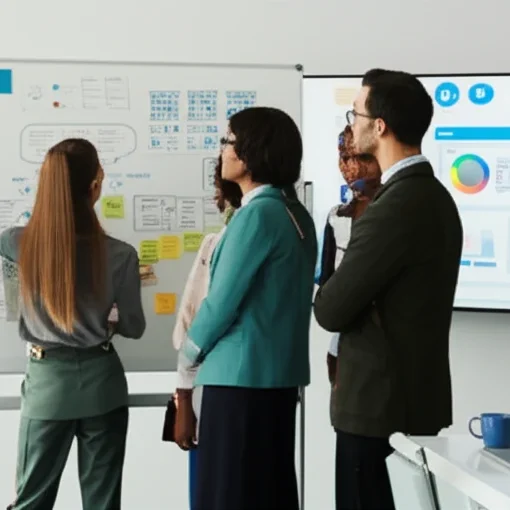Alright, let’s talk about connecting with your customers in a way that truly resonates, here in the heart of America’s Dairyland. You’ve poured your heart and soul into your Wisconsin small business – whether it’s a cozy coffee shop in Madison, a boutique in Door County, a hardware store in Fond du Lac, or a craft brewery in Milwaukee. You’ve built something special, but how do you ensure your message cuts through the noise and lands directly in the hands of people who are genuinely interested in what you offer?
In a world brimming with social media algorithms and fleeting trends, there’s one marketing channel that consistently delivers outstanding results, builds lasting relationships, and offers a remarkable return on investment: email marketing. Forget the dusty image of spam-filled inboxes; modern email marketing is about authentic connection, personalized value, and turning casual browsers into loyal customers and even brand advocates. For Wisconsin small businesses, it’s not just another marketing channel; it’s a vital tool to foster that beloved Wisconsin Nice relationship with your community, directly in their inbox.
Why Email Marketing for Your Wisconsin Business?
Think of it this way: Social media is like shouting into a busy marketplace, hoping someone hears you. Email marketing, on the other hand, is like having a private, personalized conversation with someone who wants to hear from you.
- Direct Access: When someone gives you their email address, they’re giving you permission to speak to them directly. No algorithms blocking your message, no competition for screen time with cat videos.
- Cost-Effective: Compared to paid advertising, email marketing offers an incredibly high return on investment. You own your list; you’re not renting space from a platform.
- Relationship Building: Email is perfect for nurturing leads, sharing your story, offering valuable content, and building trust over time. This is especially potent for local businesses where community connection is paramount.
- Personalization Power: With segmentation, you can tailor messages to specific interests, past purchases, or even geographic location within Wisconsin, making your communication highly relevant.
- Higher Conversion Rates: Email subscribers are often your most engaged audience. They’re more likely to make a purchase, visit your store, or attend your event than followers on other platforms.
Let’s demystify it and get you started on building these valuable connections.
Getting Started: The Essentials
You don’t need to be a tech wizard or have a massive marketing budget to begin. The core components are surprisingly straightforward.
Building Your Email List (The Foundation)
This is step one, and arguably the most vital. No list, no emails! The key is to offer value in exchange for an email address. Remember, people are protective of their inbox, so give them a good reason to opt-in.
- On Your Website: The easiest place to start. Include clear sign-up forms in prominent places – your homepage, a dedicated “newsletter” page, in your website footer, or even a pop-up (use these sparingly and politely!).
- Example: Sign up for our ‘Taste of Wisconsin’ newsletter and get 10% off your first online order of our homemade cheddar curds! or Join the ‘Badger Brew Crew’ for exclusive invites to our limited release tastings!
- In Your Physical Store/Location:
- Tablet Sign-Up: A simple tablet at your counter where customers can quickly enter their email.
- Receipt Opt-In: Ask customers at the point of sale if they’d like to receive special offers via email.
- Contests/Giveaways: Collect email addresses as entries for a prize drawing (e.g., Win a weekend getaway to Lake Geneva!).
- Events & Workshops: If you host or attend local farmers’ markets, craft fairs, or community events, have a sign-up sheet or tablet ready.
- Social Media: Occasionally promote your email list on your social channels, highlighting the exclusive value subscribers receive.
Important Note on Legality (CAN-SPAM Act): Always get explicit permission before adding someone to your email list. Never buy lists. The CAN-SPAM Act (and GDPR if you serve European customers, which is less likely for many small WI businesses but good to be aware of) requires you to:
- Not use false or misleading header information.
- Not use deceptive subject lines.
- Tell recipients where you’re located.
- Tell recipients how to opt out of receiving future emails.
- Honor opt-out requests promptly.
Choosing Your Email Marketing Platform (The Tools)
You’ll need software to manage your lists, design emails, and send them out. Think of it as your digital post office. For beginners, focus on ease of use, good customer support, and essential features.
Popular Beginner-Friendly Options:
- Mailchimp: Very popular, intuitive interface, offers a robust free plan for up to 500 contacts, making it excellent for starting out. Good for general email marketing needs.
- Constant Contact: Known for its user-friendliness and excellent customer support. Often favored by small businesses for its simplicity and event management features.
- Brevo (formerly Sendinblue): Offers a strong free plan with more sending capacity than Mailchimp for a similar number of contacts. Excellent for transactional emails and automation.
- ConvertKit: While often associated with creators and bloggers, its focus on segmentation and automation makes it powerful for businesses looking to personalize heavily. It’s a bit more advanced but quite capable.
What to Look For:
- Ease of Use: Drag-and-drop editors are a lifesaver.
- Segmentation: Ability to group your subscribers based on different criteria.
- Automation: Set up welcome series emails to send automatically to new subscribers.
- Templates: Pre-designed layouts that you can easily customize.
- Reporting: Track opens, clicks, and unsubscribes.
- Pricing: Start with a free plan or a low-cost option, then upgrade as your list grows.
Crafting Your First Emails (The Message)
Once you have a list and a platform, it’s time to communicate! Your first emails should be about introducing yourself and setting expectations.
- The Welcome Series: This is non-negotiable. When someone signs up, immediately send a welcome email. Ideally, it’s a series of 2-3 emails over a few days.
- Email 1: The Immediate Welcome. Thank them, deliver any promised incentive (e.g., discount code), briefly introduce your organization, and tell them what to expect from future emails.
- Email 2: Your Story/Values. Share why you do what you do. For a Wisconsin enterprise, this could be about your local roots, your commitment to quality, or your passion for the community.
- Email 3: A Call to Action. Guide them to explore a popular product, read a useful blog post, or follow you on social media.
- Subject Lines: This is your email’s headline – make it compelling!
- Personalize: [Name], a special offer just for you!
- Create Urgency/Curiosity: Don’t miss out: Limited edition Wisconsin cheese special ends soon! or You won’t believe what’s brewing at [Your Brewery Name]!
- Highlight Value: Your weekend guide to Door County fun (and savings!)
- Content is King (and Queen):
- Value-Driven: Don’t just sell, sell, sell. Provide useful tips, educational content, behind-the-scenes glimpses, or exclusive early access.
- Clear Call-to-Action (CTA): What do you want them to do? Shop Now, Learn More, Visit Us, RSVP Here. Make it obvious with a prominent button.
- Branding: Use your business’s logo, colors, and consistent tone of voice. Your email should instantly feel like it’s from your Wisconsin venture.
- Personalization: Beyond just using their first name, consider segmenting your list to send highly relevant content. This builds stronger bonds.
Strategies for Wisconsin Small Businesses
Now, let’s tailor this to our specific neck of the woods. Leveraging your Wisconsin identity can be a huge differentiator.
Segmentation is Your Superpower
Don’t treat all your subscribers the same. Group them based on their interests, past behaviors, or location. This allows you to send targeted messages that resonate more deeply.
- By Purchase History: If someone bought a Green Bay Packers item from your sports store, they might be interested in future Packers promotions. If they bought a specific type of cheese from your deli, they might like offers on similar items.
- By Location: For businesses with multiple locations or a wider service area, segment by city or region (e.g., Milwaukee customers vs. Madison customers) to promote local events or store-specific deals.
- Example: Special event for our Appleton customers: Join us for an exclusive tasting! or Milwaukee-area delivery special ends this week!
- By Interest: If your business has diverse offerings (e.g., a general store with both gardening supplies and local crafts), let subscribers choose their preferred content topics during sign-up.
Localized Content & Promotions
This is where your Wisconsin spirit shines through! Embrace local culture, events, and traditions.
- Leverage Wisconsin Events: Tie your promotions to major Wisconsin happenings.
- Get ready for Summerfest: Our Beer Garden is open late!
- EAA AirVenture Special: Show your badge for 15% off!
- Celebrate the State Fair: Famous Cream Puffs now in stock!
- Opening Day for the Brewers: Wear your gear and get a discount!
- Highlight Local Products/Services: Feature items sourced from Wisconsin farms, artisans, or other local businesses you collaborate with. Share the story behind them.
- Community News & Updates: If your business is involved in local charities, sponsorships, or community initiatives, share that. It builds goodwill and shows you’re truly part of the fabric of Wisconsin.
- Seasonal Specifics: From fall color tours in Door County to ice fishing season tips, tailor your content to the unique rhythm of Wisconsin’s seasons.
- Example: For a bait shop: Ice Fishing Season is HERE! Get your gear ready. For a boutique: Cozy Up for Wisconsin Winter: New Arrivals to Keep You Warm.
Nurturing Relationships (Wisconsin Nice)
Wisconsin is known for its friendly, down-to-earth nature. Translate that into your email marketing.
- Share Your Story: People love to connect with the human side of a business. Tell them about your journey, your passion, and what makes your business unique. If you’re a multi-generational family firm, share that heritage!
- Ask for Feedback: Send surveys (short ones!) to understand what your customers want. This shows you value their input.
- Be Accessible: Encourage replies to your emails. Even if you can’t respond to every single one, just having that channel open reinforces trust.
- Celebrate Milestones: Wish subscribers a happy birthday or anniversary (if you collect that data). Send a small discount as a treat.
Measuring Success & Optimizing
Email marketing isn’t a set it and forget it strategy. You need to know what’s working (and what’s not) so you can continually improve. Your email marketing platform will provide these metrics.
Key Metrics to Watch:
- Open Rate: The percentage of people who opened your email. A good open rate indicates your subject line is compelling and your list is engaged.
- Click-Through Rate (CTR): The percentage of people who clicked on a link within your email. This tells you if your content is engaging and your CTA is clear.
- Conversion Rate: The percentage of people who completed the desired action (e.g. – made a purchase, signed up for an event) after clicking a link in your email. This is the ultimate measure of ROI.
- Unsubscribe Rate: The percentage of people who opted out. A low unsubscribe rate means your content is relevant and valuable to your audience.
A/B Testing:
Most platforms allow you to send two slightly different versions of an email (e.g., different subject lines, different CTA buttons) to a small portion of your list. The version that performs better is then sent to the rest of your list. This is a powerful way to learn what resonates with your Wisconsin audience.
Iterate and Improve:
Review your reports after each send. What emails performed best? What kind of subject lines got the most opens? Use these insights to refine your future campaigns. It’s an ongoing process of learning and adapting.
Pro Tips for the Wisconsin Entrepreneur
- Consistency is Key: Don’t send one email and then disappear for six months. Decide on a realistic sending frequency (weekly, bi-weekly, monthly) and stick to it.
- Don’t Just Sell, give Value: Remember the 80/20 rule: 80% value, 20% promotion. Educate, entertain, and engage.
- Mobile-Friendly Matters: Most people check emails on their phones. guarantee your emails look great and are easy to read on small screens.
- Keep it Simple: Especially when starting. Focus on clear messages, strong CTAs, and a clean design. You don’t need fancy animations or complex layouts.
- Tell Your Story: This is particularly powerful for Wisconsin small businesses. Your customers want to support you, not just a faceless brand. Share your passion, your roots, and your connection to the community.
- Embrace the “Nice”: Be genuine, be helpful, and build rapport. This is the essence of Wisconsin customer service, and it translates beautifully to email marketing.
Your Next Step: Start Today!
Email marketing might seem daunting at first, but it’s remarkably accessible and incredibly powerful for small businesses like yours. It’s a direct line to your most valuable asset: your customers. By building your list, sending valuable, localized cont – t, and continually learning, you’ll forge stronger relationships, drive more sales, and truly embed your Wisconsin business deeper into the community.
So, go ahead. Pick an email marketing platform, set up your first sign-up form, and send that initial welcome email. Your customers are waiting to hear from you. Let’s make your inbox a place where Wisconsin customers truly feel at home.



